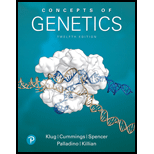
Some mutations in the tra gene of Drosophila cause XX individuals to appear as males. In contrast, other mutations in tra cause XY flies to appear as females. Which of these
HINT: This problem involves an understanding of the Sxl regulatory pathway in Drosophila. The key to its solution is to review the functions of the normal TRA protein in Drosophila males and females.
To describe: The phenotype that would be expected if a mutation in tra gene results into null allele.
Introduction: The sex of Drosophila melanogaster is determined by the ratio of sex chromosomes to autosomes. The male Drosophila melanogaster is produced when the ratio of sex chromosomes to autosomes is 0.5. However, the female Drosophila melanogaster is produced when the ratio is 1.0.
Explanation of Solution
The tra gene is present in both male and female Drosophila melanogaster. The activity of tra gene is controlled by Sxl gene. In the absence of Sxl gene, the tra gene is spliced in a way that stop codon “UGA” remains present in the mature mRNA. This is observed in male Drosophila melanogaster as they lack the Sxl gene. The translation of mRNA with stop codon leads to the formation of a non-functional protein. However, in female Drosophila melanogaster, the Sxl gene promotes the removal of “UGA” from mRNA, and this forms a functional tra protein.
The mutation in the null allele leads to the formation of male Drosophila melanogaster. This is because the null gene has no effect on the Sxl gene. It does not activate the Sxl gene. The inactivated Sxl gene cannot remove the UGA gene from mRNA, and this leads to the formation of male Drosophila.
Thus, male Drosophila melanogaster would be expected if a mutation in the tra gene occurs in null allele.
To determine: The phenotype that would be expected if mutation produces a constitutively active tra gene.
Introduction: The ratio of sex chromosomes to autosomes is termed as chromosomal ratio. The chromosomal ratio is analyzed by three genes. These are sex-lethal (Sxl), transformer (tra), and doublesex (dsx). The activity of tra gene plays a crucial role in determining the sex of Drosophila.
Explanation of Solution
The activity of tra gene depends upon the Sxl gene. The active tra gene indicates that there is Sxl gene. The tra gene in the presence of the Sxl gene is able to remove the stop codon “UGA” from the mRNA. It produces a function tra protein. The active tra protein is found in female Drosophila. However, the male Drosophila has inactive tra protein. This indicates that female Drosophila would be expected if the mutation produces a constitutively active tra gene.
Thus, the phenotype that would be expected if mutation produces a constitutively active tra gene is a female Drosophila melanogaster.
Want to see more full solutions like this?
Chapter 18 Solutions
Concepts of Genetics Plus Mastering Genetics with Pearson eText -- Access Card Package (12th Edition) (What's New in Genetics)
- What did the Cre-lox system used in the Kikuchi et al. 2010 heart regeneration experiment allow researchers to investigate? What was the purpose of the cmlc2 promoter? What is CreER and why was it used in this experiment? If constitutively active Cre was driven by the cmlc2 promoter, rather than an inducible CreER system, what color would you expect new cardiomyocytes in the regenerated area to be no matter what? Why?arrow_forwardWhat kind of organ size regulation is occurring when you graft multiple organs into a mouse and the graft weight stays the same?arrow_forwardWhat is the concept "calories consumed must equal calories burned" in regrads to nutrition?arrow_forward
- You intend to insert patched dominant negative DNA into the left half of the neural tube of a chick. 1) Which side of the neural tube would you put the positive electrode to ensure that the DNA ends up on the left side? 2) What would be the internal (within the embryo) control for this experiment? 3) How can you be sure that the electroporation method itself is not impacting the embryo? 4) What would you do to ensure that the electroporation is working? How can you tell?arrow_forwardDescribe a method to document the diffusion path and gradient of Sonic Hedgehog through the chicken embryo. If modifying the protein, what is one thing you have to consider in regards to maintaining the protein’s function?arrow_forwardThe following table is from Kumar et. al. Highly Selective Dopamine D3 Receptor (DR) Antagonists and Partial Agonists Based on Eticlopride and the D3R Crystal Structure: New Leads for Opioid Dependence Treatment. J. Med Chem 2016.arrow_forward
- The following figure is from Caterina et al. The capsaicin receptor: a heat activated ion channel in the pain pathway. Nature, 1997. Black boxes indicate capsaicin, white circles indicate resinferatoxin. You are a chef in a fancy new science-themed restaurant. You have a recipe that calls for 1 teaspoon of resinferatoxin, but you feel uncomfortable serving foods with "toxins" in them. How much capsaicin could you substitute instead?arrow_forwardWhat protein is necessary for packaging acetylcholine into synaptic vesicles?arrow_forward1. Match each vocabulary term to its best descriptor A. affinity B. efficacy C. inert D. mimic E. how drugs move through body F. how drugs bind Kd Bmax Agonist Antagonist Pharmacokinetics Pharmacodynamicsarrow_forward
 Human Heredity: Principles and Issues (MindTap Co...BiologyISBN:9781305251052Author:Michael CummingsPublisher:Cengage Learning
Human Heredity: Principles and Issues (MindTap Co...BiologyISBN:9781305251052Author:Michael CummingsPublisher:Cengage Learning Biology (MindTap Course List)BiologyISBN:9781337392938Author:Eldra Solomon, Charles Martin, Diana W. Martin, Linda R. BergPublisher:Cengage Learning
Biology (MindTap Course List)BiologyISBN:9781337392938Author:Eldra Solomon, Charles Martin, Diana W. Martin, Linda R. BergPublisher:Cengage Learning Biology Today and Tomorrow without Physiology (Mi...BiologyISBN:9781305117396Author:Cecie Starr, Christine Evers, Lisa StarrPublisher:Cengage Learning
Biology Today and Tomorrow without Physiology (Mi...BiologyISBN:9781305117396Author:Cecie Starr, Christine Evers, Lisa StarrPublisher:Cengage Learning Biology 2eBiologyISBN:9781947172517Author:Matthew Douglas, Jung Choi, Mary Ann ClarkPublisher:OpenStax
Biology 2eBiologyISBN:9781947172517Author:Matthew Douglas, Jung Choi, Mary Ann ClarkPublisher:OpenStax Concepts of BiologyBiologyISBN:9781938168116Author:Samantha Fowler, Rebecca Roush, James WisePublisher:OpenStax College
Concepts of BiologyBiologyISBN:9781938168116Author:Samantha Fowler, Rebecca Roush, James WisePublisher:OpenStax College





